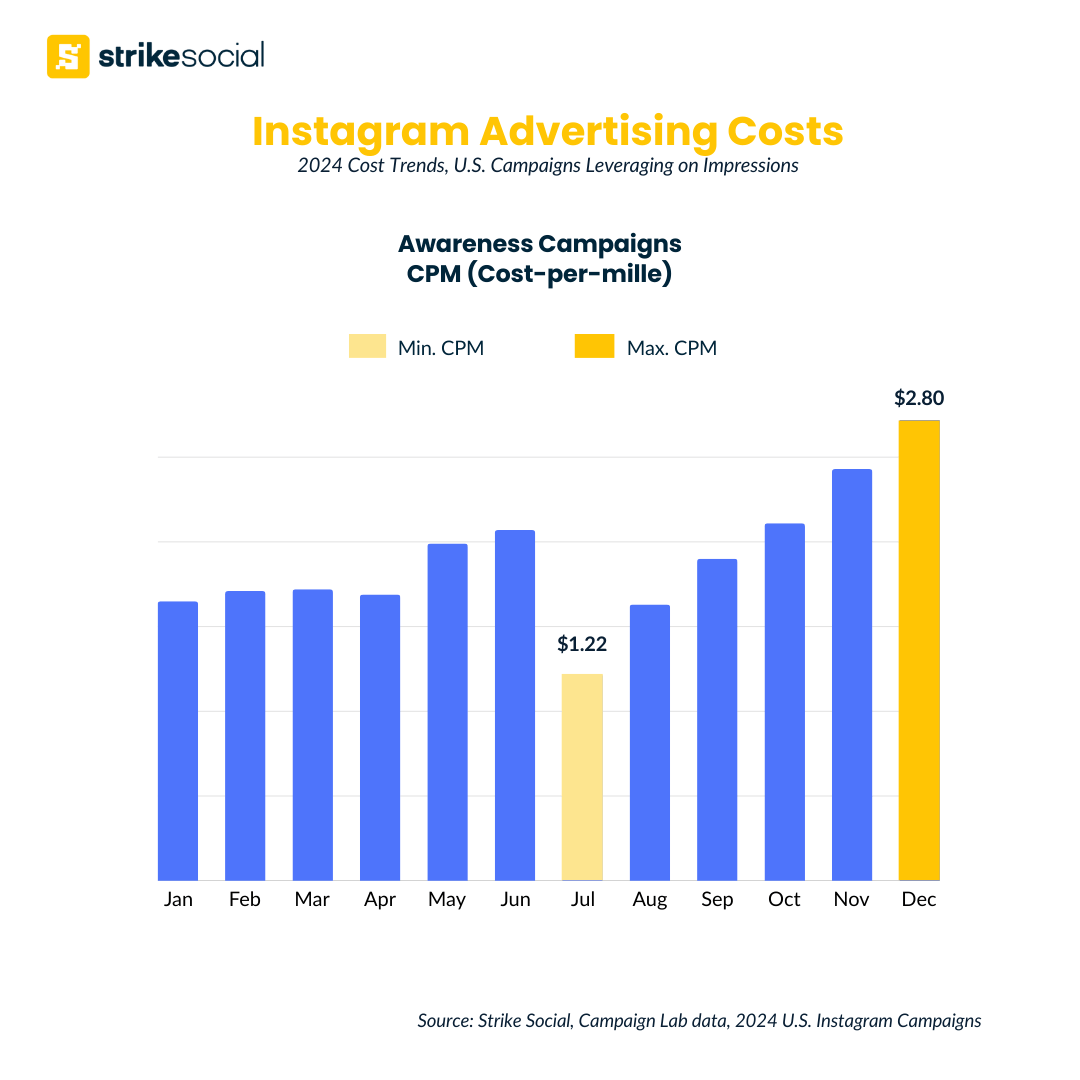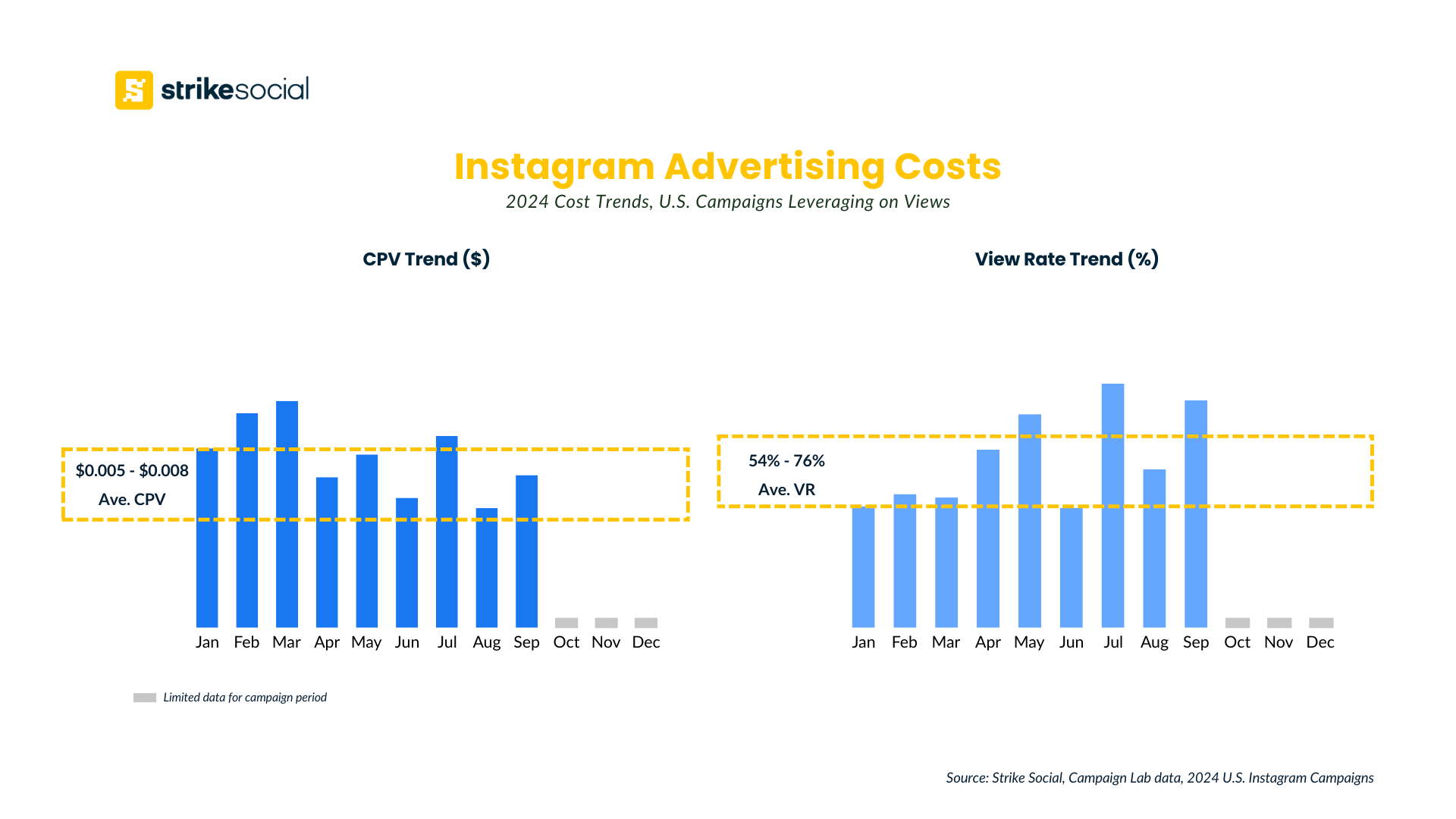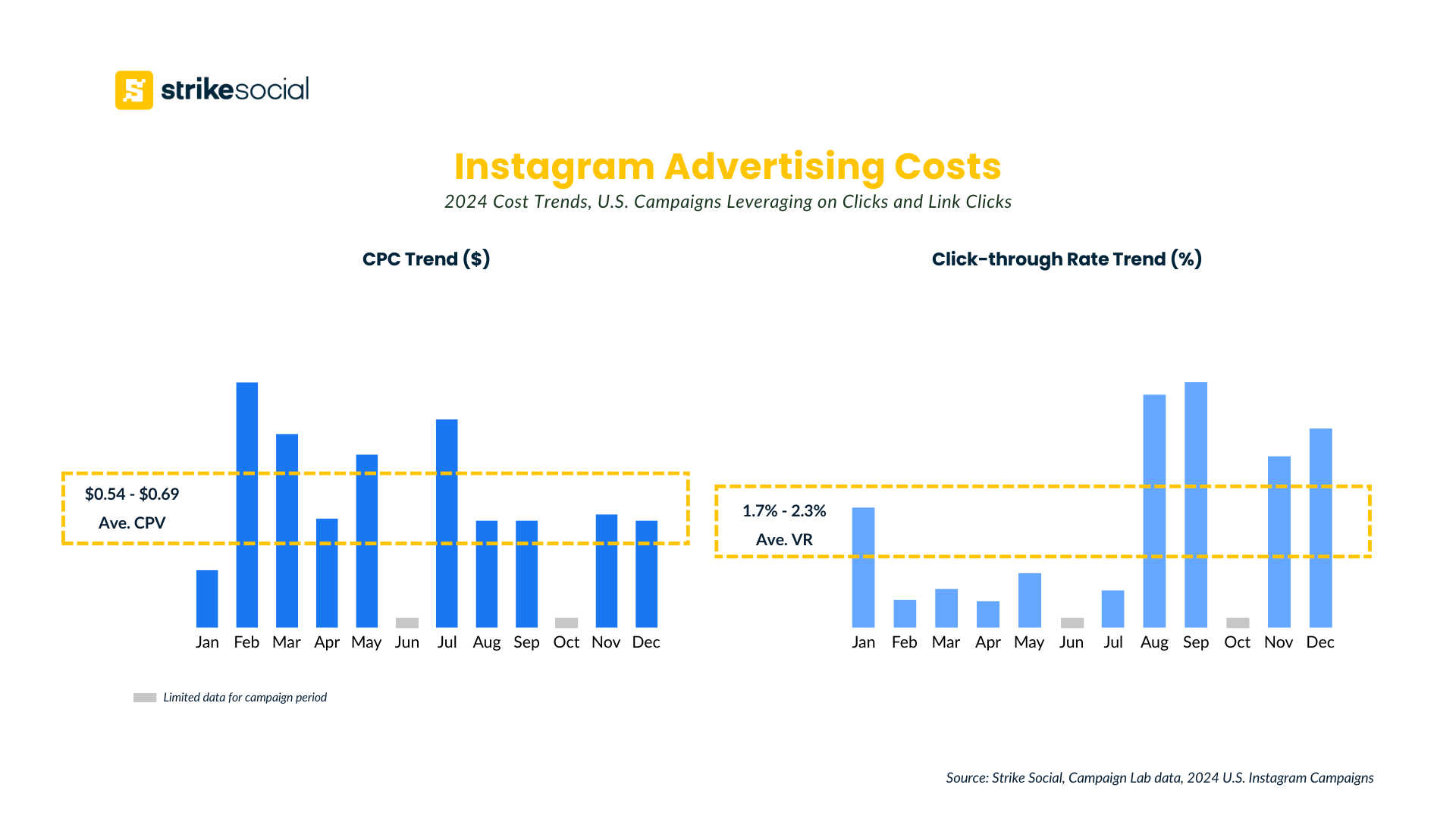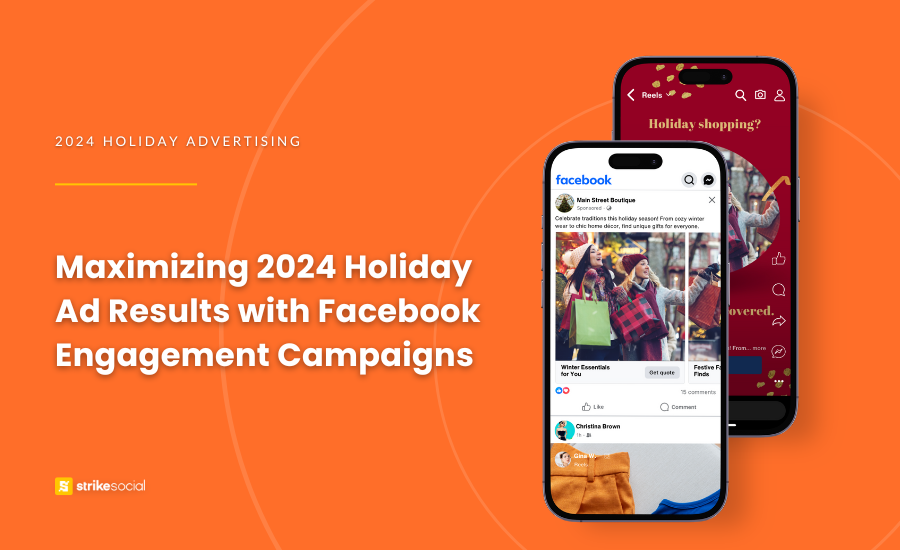Strike Overview
- Understand Instagram ads cost with Strike Social’s complete data-driven guide. From forward and reverse-planning calculators to essential formulas, you’ll have the tools to forecast spend, estimate outcomes, and align your budget with campaign goals.
- See our benchmarks from thousands of campaigns, including CPM, CPV, and CPC ranges. Learn how costs shift with seasonality, placements, and audience targeting; insights you can use to anticipate changes and optimize your campaigns year-round.
- With strategies around creative testing, bidding, and Meta’s algorithm tools, you can better optimize your Instagram advertising costs and maximize return on ad spend.
Jump to Section
This post was updated in September 2025 to provide you with the latest information.
Instagram Ads Cost Guide: Benchmarks and Tools for Budget Planning
For paid social media advertisers, understanding the true cost of Instagram ads can feel elusive. There isn’t a fixed price tag; costs shift based on your strategy, target audience, and how effectively you work with the Meta ad auction. Your Instagram advertising costs depend on multiple factors, but there are clear benchmarks and formulas that can guide your budget.
This guide provides a data-driven look at Instagram advertising costs, built on Strike Social’s insights and benchmarks. Before we discuss CPCs, CPMs, and real campaign data, we’ll outline a strategic framework, complete with an Instagram ad cost calculator, to help you estimate, plan, and optimize your ad spend across any type of Instagram ad campaign.
How to Calculate Instagram Ad Costs
The best way to estimate Instagram ad costs is to start with a strategic framework. Strike Social provides tools that help you assess campaign budgets in advance, so your media buying team can plan with precision instead of guesswork.
Instagram Ad Cost Calculator
There are two primary ways to approach your ad cost calculations: planning based on a set budget, or planning based on your campaign goals.
Forward Calculation (planning based on a set budget):
- Ad Spend: Your planned campaign budget.
- Estimated Daily Results: Projections from Meta Ads Manager, such as impressions, thruplays, or link clicks, depending on your objective.
- Campaign Duration: The total length of your campaign.
- The Instagram ad cost calculator will then show your estimated CPM, CPV, or CPC.
Instagram CPM Calculator
Estimated CPM: $0.00
This calculation is an estimate and should be used as a baseline for planning purposes only. Actual results may vary.
Note: CPM is calculated based on estimated reach and assumes no frequency cap is applied.
Instagram CPV Calculator
Estimated CPV: $0.0000
This calculation is an estimate and should be used as a baseline for planning purposes only. Actual results may vary.
Instagram CPC Calculator
Estimated CPC: $0.00
This calculation is an estimate and should be used as a baseline for planning purposes only. Actual results may vary.
Reverse-Planning (planning based on a set campaign goal):
- Target Cost Per Acquisition (CPA): The maximum amount you’re willing to pay for a click, view, or conversion.
- Target Impressions / Views / Clicks: Your projected outcomes (e.g., impressions, video views, or link clicks).
- Campaign Duration: How many days your campaign will run.
- The calculator then projects the budget needed to reach your conversion goals.
Instagram Budget Calculator for Impressions Campaign
Estimated Campaign Budget: $0.00
This budget estimate is provided for planning purposes only and may not reflect actual campaign spend.
Instagram Budget Calculator for Views Campaign
Estimated Campaign Budget: $0.00
This budget estimate is provided for planning purposes only and may not reflect actual campaign spend.
Instagram Budget Calculator for Clicks Campaign
Estimated Campaign Budget: $0.00
This budget estimate is provided for planning purposes only and may not reflect actual campaign spend.
Core Formulas to Understand
Behind the Instagram ad cost calculator we have built are formulas every paid social strategist should know:
- Estimated Cost per Action = (Ad Spend) ÷ (Number of Actions)
- For impressions campaigns, multiply by 1,000.
- Budget Needed = (Target Number of Conversions) × (Target Cost Per Conversion)
Mastering these calculations shifts budgeting from guesswork to a data-driven, strategic ad spend allocation across any Instagram advertising campaign.
Key Cost Benchmarks for Instagram Ad Campaigns
At Strike Social, we analyze thousands of campaigns to understand the actual cost of Instagram ads. These are the typical cost ranges you can expect, which you can use as inputs for the calculator above.
Keep in mind that the lower end of these ranges typically represents highly optimized campaigns with strong creative and targeting, while the higher end reflects more competitive markets.
Cost Per Mille (CPM): Impressions
- What it is: The cost for every 1,000 ad impressions. This is the primary metric for brand awareness and reach campaigns.
- Our data shows: Instagram CPMs typically range from $1.22 to $2.80, with clear seasonal fluctuations. Costs peak in Q4, as competition intensifies during the holiday advertising surge. Conversely, a mid-summer CPM dip during July can present a cost-effective opportunity for brands to maximize reach.

Cost Per View (CPV): Video Views
- What it is: The cost of a single video play or view, often used for Instagram Stories and Reels campaigns.
- Our data shows: Campaigns optimized for views reveal a dynamic interplay between cost and engagement. On average, Instagram ad CPVs range between $0.005 and $0.008, with view rates typically between 54% and 76%.
During peak months, view rates can surge beyond 90%, demonstrating the high level of attention that Instagram audiences can have. However, the lowest CPV does not always correspond to the highest view rate. This means savvy advertisers can capitalize on different seasonal windows: some months deliver maximum cost-efficiency, while others provide peak user engagement.

Cost Per Click (CPC): Clicks & Link Clicks
- What it is: CPC measures the price of a click on your ad, whether it’s anywhere on the creative or directly on a link. It’s a key indicator of the cost associated with driving user interaction and traffic.
- Our data shows: Instagram CPCs average between $0.54 and $0.69, varying widely depending on how audiences respond to your ads. We see a clear inverse relationship between Click-Through Rate (CTR) and CPC: when CTR climbs, CPC drops.
Throughout the year, CTR can range from below 1% to nearly 5% during peak engagement months. These fluctuations directly impact efficiency, as the lowest CPCs consistently align with periods of the highest audience engagement.

The Core Factors That Determine Your Instagram Ad Cost
Your Instagram ad costs aren’t fixed; they shift based on how you manage campaigns and the strategies you use. Mastering these key levers is the fastest way to influence benchmarks in your favor:
- Audience Targeting: Your target audience is one of the biggest cost drivers. Broad, untargeted audiences often yield lower CPMs but weaker performance, while hyper-specific, high-value audiences are smaller and more competitive, pushing auction prices higher.
If you’re unsure of your ideal demographic, start with Advantage+ audience to let Meta’s algorithm identify strong segments. As you build sufficient first-party data, transition to manual setups for greater control and precision. - Ad Placements: Where your ad appears: on Feed, Stories, or Explore; affects both price and performance. Highly competitive placements can be more expensive, while emerging ones, such as Reels, often deliver greater efficiency.
For a broader reach and increased awareness, utilize Advantage+ placements to enable Meta to distribute ads across all surfaces. Once your campaign data shows where your campaigns perform best, especially in lower-funnel objectives, narrow placements to those that consistently drive stronger engagement. - Seasonality & Competition: Costs fluctuate based on demand. Q4, with its holiday ad surge, consistently sees CPMs peak, while mid-summer often provides cost-efficient windows.
To manage seasonal spikes, plan early budgets for Q4 and use quieter months for testing new creatives at lower costs.
Further Reading

Maximizing Q4 Holiday Ad Results with Post-Engagement Campaigns
Thanksgiving and Christmas post-engagement campaigns provide an effective method to re-engage viewers scrolling through Meta platforms. These campaigns are a powerful strategy for turning your brand’s reach and visibility into stronger interactions and improved conversions, ensuring a highly effective holiday season.
- Campaign Objective: The deeper your objective in the funnel, the higher your costs. Reach and Engagement campaigns are typically less expensive per result, while Sales or Leads campaigns demand more, as Meta must identify high-intent users.
Utilize upper-funnel campaigns to establish awareness, and then retarget with conversion-focused campaigns to optimize efficiency throughout the customer journey. - Bidding Strategy: Your bidding strategy has a direct impact on delivery and spend. “Highest Volume” maximizes reach but offers less control, while “Cost Per Result Goal” helps stabilize efficiency but can restrict scale.
Test both strategies to determine where the sweet spot for you cost-per-action (CPA) lies, and adjust accordingly to meet your campaign goals.
Optimizing Your Instagram Ad Campaign Budgets
Ultimately, the cost of Instagram ads is not a fixed expense but a variable you can actively control. By moving beyond the simple question of "how much" and focusing instead on strategic targeting, compelling creative, and 24/7 optimization, you can build a highly cost-effective advertising engine. This data-driven approach is what transforms an ad budget from an expense into a powerful investment in growth.
Ready to build a cost-effective advertising strategy that drives real results? Contact our paid social experts at Strike Social today.
Article by
Lee Baler, Strike Social’s VP of Sales & Strategy
Lee leads global strategy, helping clients and agencies maximize YouTube and paid social performance. Constantly tracking industry trends, he translates insights into strategies that help brands stay competitive and achieve sustained profitability.








